Similar presentations:
SQL Access Control
1.
AUDITDB SECURITY MECHANISMS
MASKING
Encryption
Authentication
OS AUTH
DB AUTH
NET AUTH
KERBEROS
DB FILES
DES
Network
Traffic
-IPSec
-SSL
Access Control
Discretionary
Mandatory
(users, roles,
privileges)
TRIPLE_
DES
RC_2
Views,
RC_4
DESX
Triggers,
AES_128
Stored
AES_192
procedures
AES_256
Transparent Data Encryption (for SQL Server 2008 only)
2.
Discretionary Access ControlUSERS
ROLES
PRIVILEGES
PROFILES
(In Oracle)
3.
USERS AND ROLESUsers
Roles
Privileges
Jenny
HR_MGR
Delete
employees
Insert
employees
David
Rachel
HR_CLERK
Select
employees
Update
employees
4. Privileges
Database security:System security
Data security
System privileges: Gaining access to the
database
Object privileges: Manipulating the content of
the database objects
5. System Privileges
More than 100 privileges are available.The database administrator has high-level
system privileges for tasks such as:
Creating new users
Removing users
Removing tables
Backing up tables
6. Oracle Access Control
7. Creating Users
The DBA creates users with the CREATE USER statement.CREATE USER user
IDENTIFIED BY
password;
CREATE USER HR
IDENTIFIED BY
HR;
User created.
8. User System Privileges
After a user is created, the DBA can grant specific systemprivileges to that user.
GRANT privilege [, privilege...]
TO user [, user| role, PUBLIC...];
An application developer, for example, may have the
following system privileges:
CREATE SESSION
CREATE TABLE
CREATE SEQUENCE
CREATE VIEW
CREATE PROCEDURE
9. Granting System Privileges
The DBA can grant specific system privileges to a user.GRANT
create session, create table,
create sequence, create view
TO
scott;
Grant succeeded.
10. Creating and Granting Privileges to a Role
Create a roleCREATE ROLE manager;
Role created.
Grant privileges to a role
GRANT create table, create view
TO manager;
Grant succeeded.
Grant a role to users
GRANT manager TO DE HAAN, KOCHHAR;
Grant succeeded.
11. Changing Your Password
The DBA creates your user account and initializes yourpassword.
You can change your password by using the ALTER
USER statement.
ALTER USER HR
IDENTIFIED BY employ;
User altered.
12. Object Privileges
ObjectPrivilege
Table
ALTER
DELETE
View
Sequence
Procedure
EXECUTE
INDEX
INSERT
REFERENCES
SELECT
UPDATE
13. Object Privileges
Object privileges vary from object to object.An owner has all the privileges on the object.
An owner can give specific privileges on that owner’s
object.
GRANT
object_priv [(columns)]
ON
object
TO
{user|role|PUBLIC}
[WITH GRANT OPTION];
14. Granting Object Privileges
Grant query privileges on the EMPLOYEES table.GRANT select
ON
employees
TO
sue, rich;
Grant succeeded.
Grant privileges to update specific columns to users and
roles.
GRANT update (department_name, location_id)
ON
departments
TO
scott, manager;
Grant succeeded.
15. Passing On Your Privileges
Give a user authority to pass along privileges.GRANT select, insert
ON
departments
TO
scott
WITH
GRANT OPTION;
Grant succeeded.
Allow all users on the system to query data from Alice’s
DEPARTMENTS table.
GRANT select
ON
alice.departments
TO
PUBLIC;
Grant succeeded.
16. Confirming Privileges Granted
Data Dictionary ViewDescription
ROLE_SYS_PRIVS
System privileges granted to roles
ROLE_TAB_PRIVS
Table privileges granted to roles
USER_ROLE_PRIVS
Roles accessible by the user
USER_TAB_PRIVS_MADE Object privileges granted on the user’s
objects
USER_TAB_PRIVS_RECD Object privileges granted to the user
USER_COL_PRIVS_MADE Object privileges granted on the
columns of the user’s objects
USER_COL_PRIVS_RECD Object privileges granted to the user on specific
columns
USER_SYS_PRIVS
System privileges granted to the
user
17. Revoking Object Privileges
You use the REVOKE statement to revoke privilegesgranted to other users.
Privileges granted to others through the WITH GRANT
OPTION clause are also revoked.
REVOKE {privilege [, privilege...]|ALL}
ON
object
FROM
{user[, user...]|role|PUBLIC}
[CASCADE CONSTRAINTS];
18. Revoking Object Privileges
As user Alice, revoke the SELECT and INSERT privilegesgiven to user Scott on the DEPARTMENTS table.
REVOKE select, insert
ON
departments
FROM
scott;
Revoke succeeded.
19. Revoking Object Privileges
As user Alice, revoke the SELECT and INSERT privilegesgiven to user Scott on the DEPARTMENTS table.
REVOKE select, insert
ON
departments
FROM
scott;
Revoke succeeded.
20.
PROFILE CREATION21.
PROFILE CREATION22. SQL Server Access Control
23.
LOGIN CREATIONCREATE LOGIN login_name { WITH <option_list1> | FROM <sources> }
<sources> ::= WINDOWS [ WITH <windows_options> [ ,... ] ]
| CERTIFICATE certname
| ASYMMETRIC KEY asym_key_name
<option_list1> ::=
PASSWORD = 'password' [ HASHED ] [ MUST_CHANGE ]
[ , <option_list2> [ ,... ] ]
<option_list2> ::= SID = sid | DEFAULT_DATABASE = database |
DEFAULT_LANGUAGE = language |
CHECK_EXPIRATION = { ON | OFF} |
CHECK_POLICY = { ON | OFF} [ CREDENTIAL = credential_name ]
<windows_options> ::=
DEFAULT_DATABASE = database |
DEFAULT_LANGUAGE = language
NOT RECOMMENDED (For SQL Server authentication only)
sp_addlogin
24.
USER AND ROLE CREATIONCREATE USER user_name
[ { { FOR | FROM }
{ LOGIN login_name
| CERTIFICATE cert_name
| ASYMMETRIC KEY asym_key_name
}
| WITHOUT LOGIN ]
[ WITH DEFAULT_SCHEMA = schema_name ]
CREATE ROLE role_name [ AUTHORIZATION owner_name ]
NOT RECOMMENDED: sp_adduser, sp_addgroup
EXAMPLE
CREATE LOGIN testUser
WITH PASSWORD = '8fdKJl3$nlNv3049jsKK';
USE myDB;
CREATE USER testUSR
FOR LOGIN testUser
WITH DEFAULT_SCHEMA = myDB;
GO
25.
ADDING USERS TO FIXED SERVER AND DB ROLESsp_addsrvrolemember [ @loginame= ] 'login'
, [ @rolename = ] 'role‘
sp_dropsrvrolemember [ @loginame = ] 'login'
, [ @rolename = ] 'role'
sp_addrolemember [ @rolename = ] 'role',
[ @membername = ] 'security_account‘
sp_droprolemember [ @rolename = ] 'role' ,
[ @membername = ] 'security_account’
26.
PRIVELEGES GRANTSYMPLIFIED SYNTAX
GRANT { ALL [ PRIVILEGES ] }
permission [ ( column [ ,...n ] ) ] [ ,...n ]
[ ON [ class :: ] securable ]
TO principal [ ,...n ] [ WITH GRANT OPTION ] [ AS principal ]
GRANT OBJECT PRIVELEGES
GRANT <permission> [ ,...n ] ON
[ OBJECT :: ][ schema_name ]. object_name [ ( column [ ,...n ] ) ]
TO <database_principal> [ ,...n ]
[ WITH GRANT OPTION ]
[ AS <database_principal> ]
<permission> ::= ALL [ PRIVILEGES ]
| permission [ ( column [ ,...n ] ) ]
<database_principal> ::= Database_user | Database_role | Application_role |
Database_user_mapped_to_Windows_User | Database_user_mapped_to_Windows_Group |
Database_user_mapped_to_certificate | Database_user_mapped_to_asymmetric_key |
Database_user_with_no_login
27.
PRIVELEGES REVOKESYMPLIFIED SYNTAX
REVOKE [ GRANT OPTION FOR ]
{
[ ALL [ PRIVILEGES ] ] |
permission [ ( column [ ,...n ] ) ] [ ,...n ]
}
[ ON [ class :: ] securable ]
{ TO | FROM } principal [ ,...n ] [ CASCADE] [ AS principal ]
REVOKE OBJECT PRIVELEGES
REVOKE [ GRANT OPTION FOR ] <permission> [ ,...n ] ON
[ OBJECT :: ][ schema_name ]. object_name
[ ( column [ ,...n ] ) ]
{ FROM | TO } <database_principal> [ ,...n ]
[ CASCADE ] [ AS <database_principal> ]
28.
PRIVELEGES DENYSYMPLIFIED SYNTAX
DENY { ALL [ PRIVILEGES ] }
| permission [ ( column [ ,...n ] ) ] [ ,...n ]
[ ON [ class :: ] securable ]
TO principal [ ,...n ] [ CASCADE] [ AS principal ]
DENY OBJECT PRIVELEGES
DENY <permission> [ ,...n ] ON
[ OBJECT :: ][ schema_name ]. object_name [ ( column [ ,...n ] ) ]
TO <database_principal> [ ,...n ]
[ CASCADE ] [ AS <database_principal> ]
29.
APPLICATION ROLESBiblio DB
select on Readers... select on Books...
My application role
Insert on Readers...
UNAUTHORIZED
APPLICATION
AUTHORIZED
APPLICATION
CONNECT
CONNECT
USER1
UNAUTHORIZED
APPLICATION
USER2
CONNECT
USER3
30.
USING APPLICATIONS ROLESCREATING APPLICATION ROLE
CREATE APPLICATION ROLE application_role_name
WITH PASSWORD = 'password'
[ , DEFAULT_SCHEMA = schema_name ]
SETTING APPLICATION ROLE
sp_setapprole [ @rolename = ] 'role',
[ @password = ] { encrypt N'password' }
|
'password' [ , [ @encrypt = ] { 'none' | 'odbc' } ]
[ , [ @fCreateCookie = ] true | false ] [ ,
[ @cookie = ] @cookie OUTPUT ]
31.
ORACLE FINE GRAINED ACCESS CONTROL (VPD)Id
2
Security
policies
SELECT
3
149
145
145
Function:
1
4
...
WHERE account_mgr_id = 148
...
5
Account manager 148
149
147
147
149
148
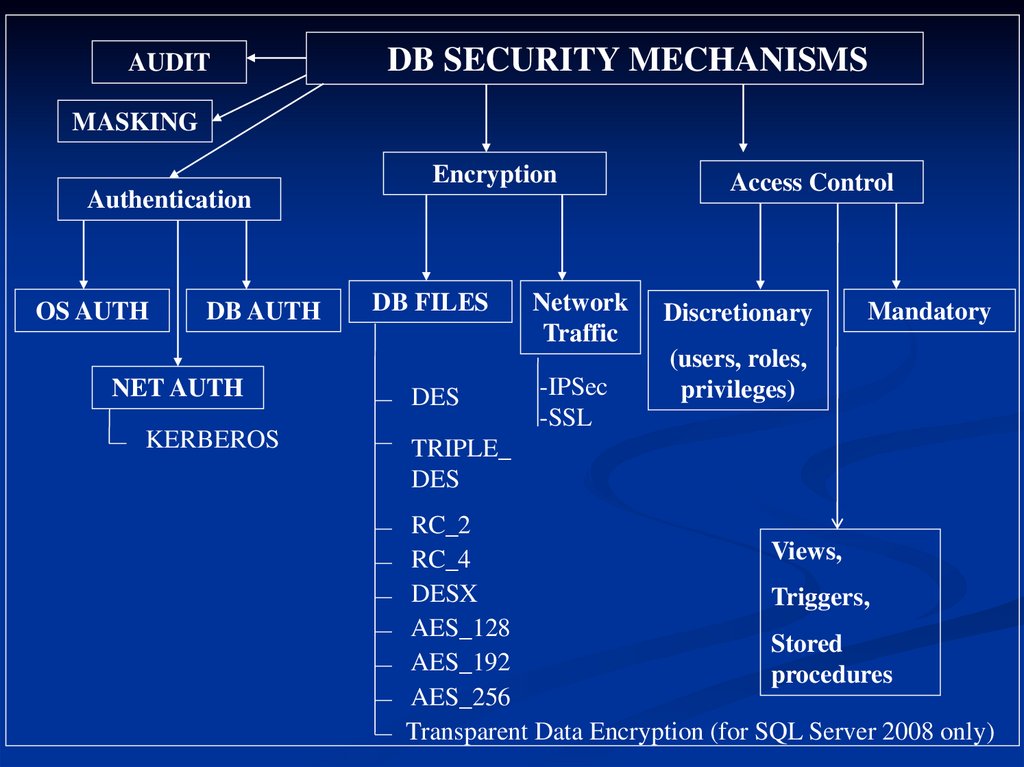













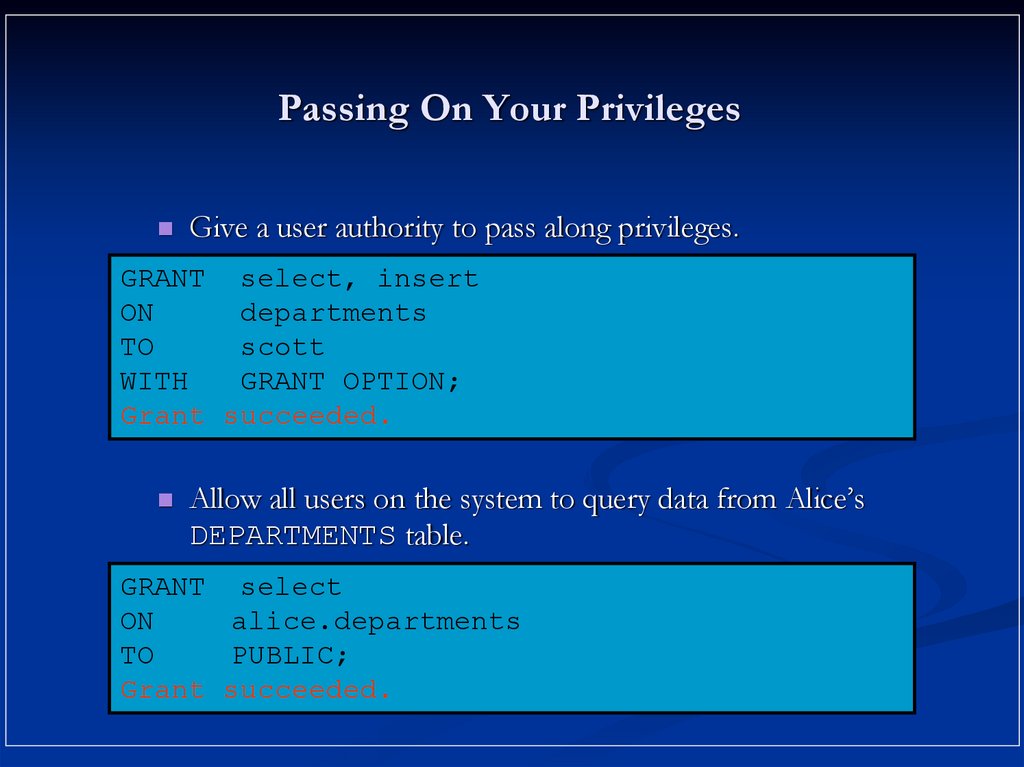
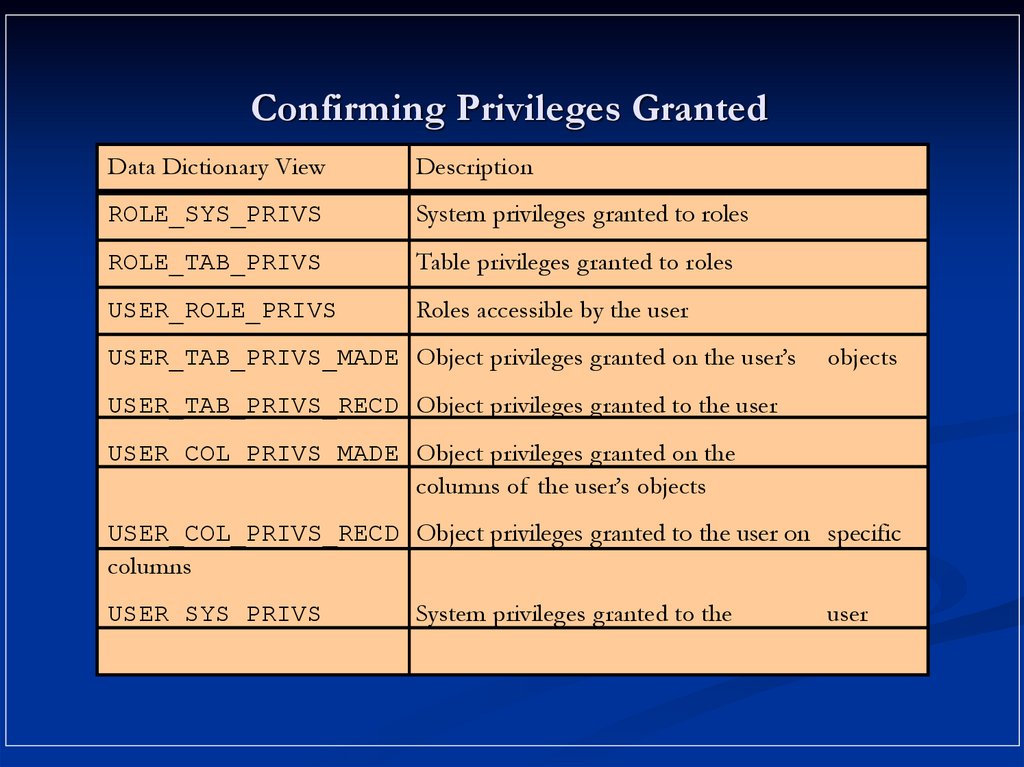

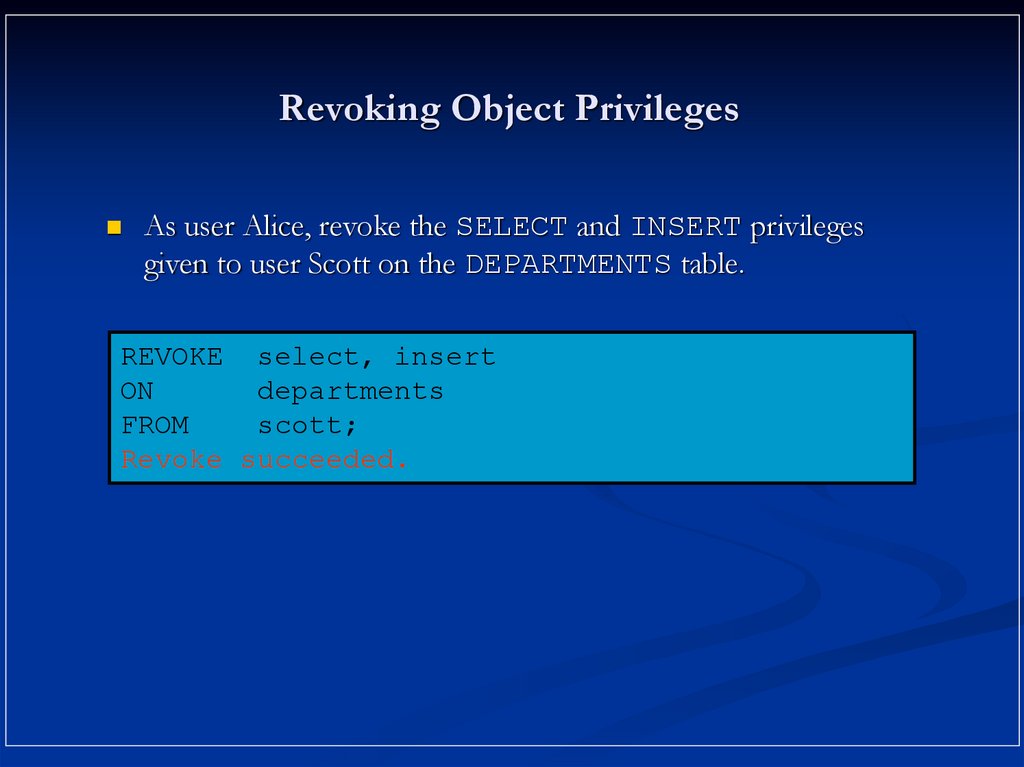
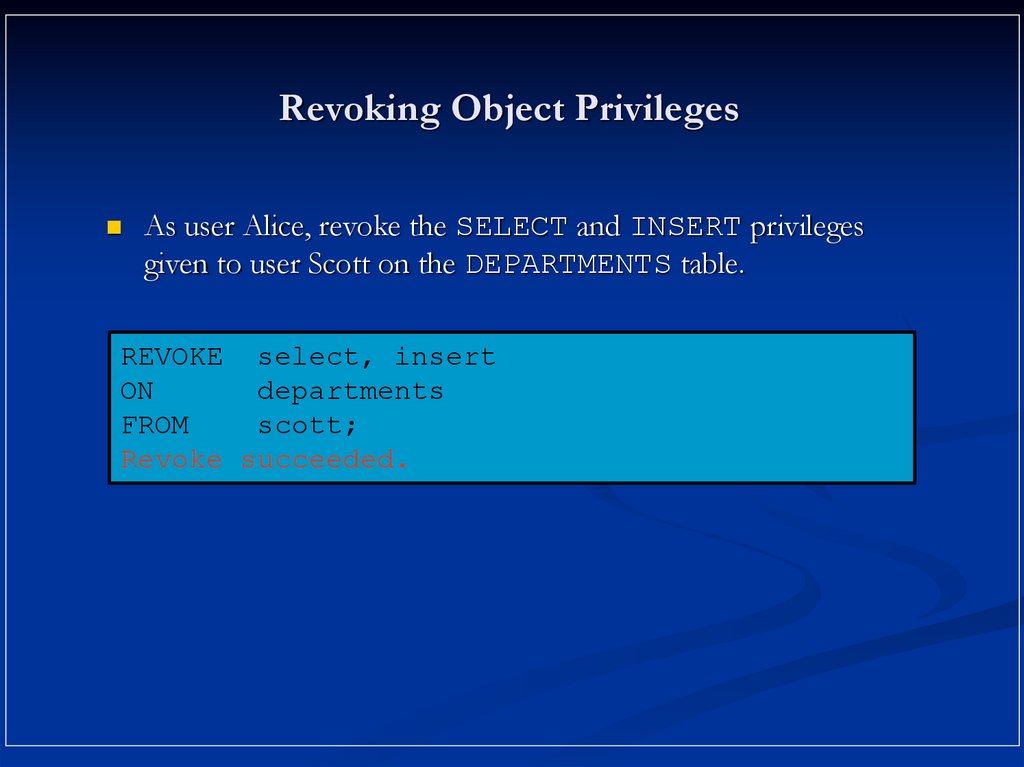
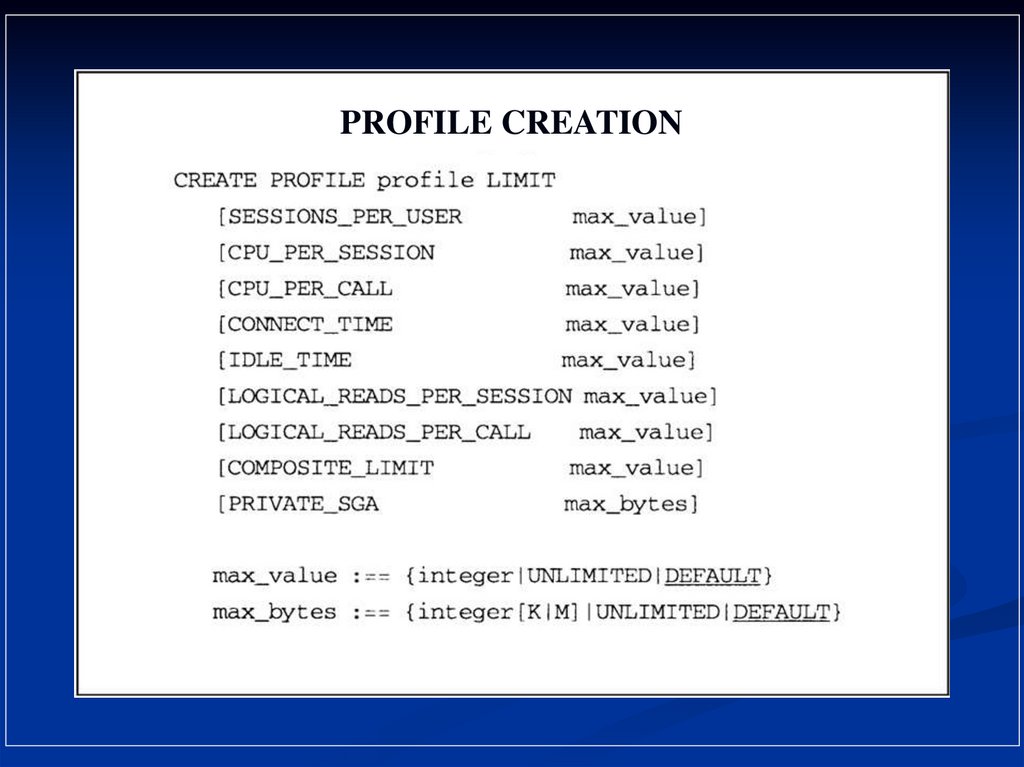
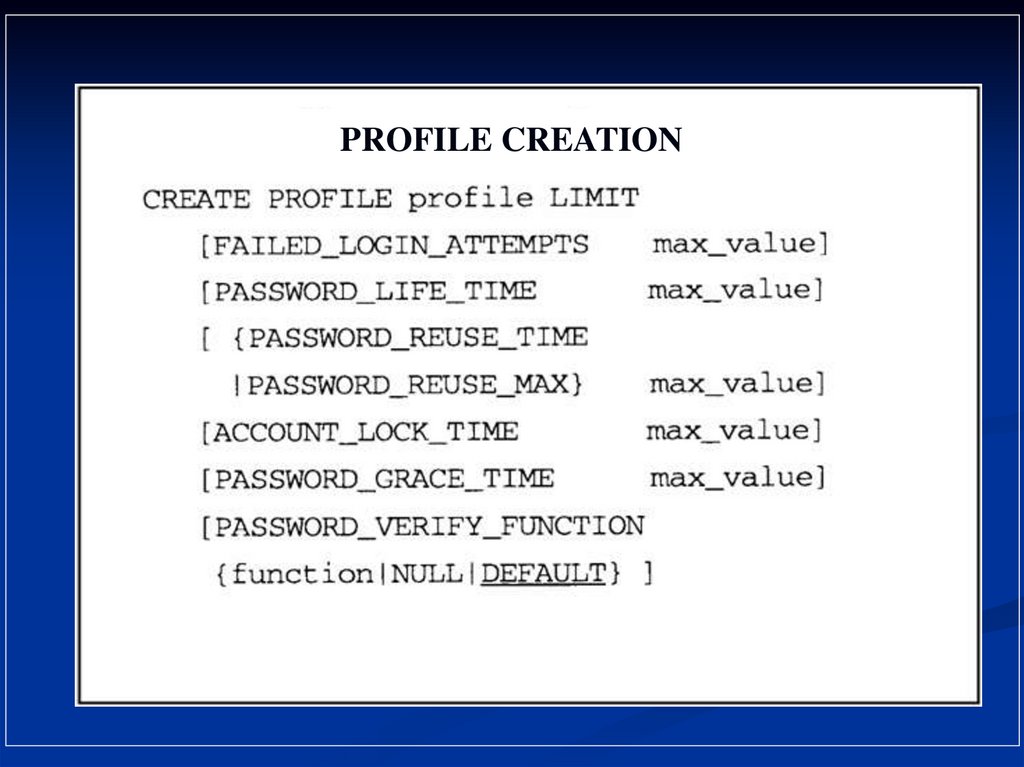
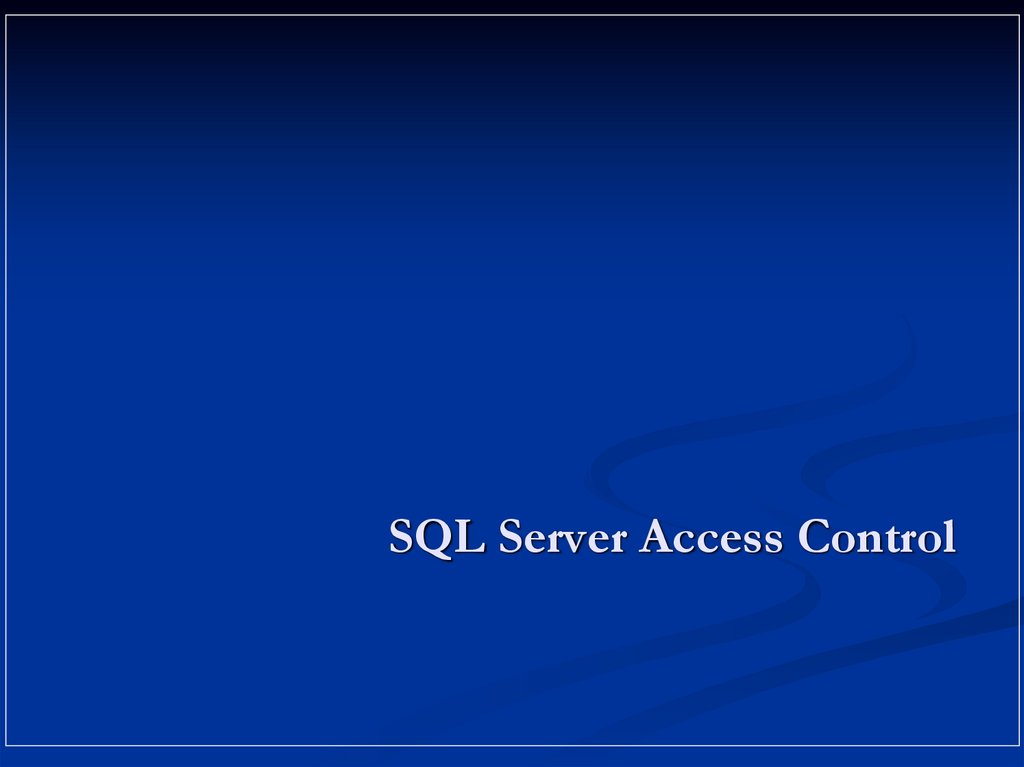
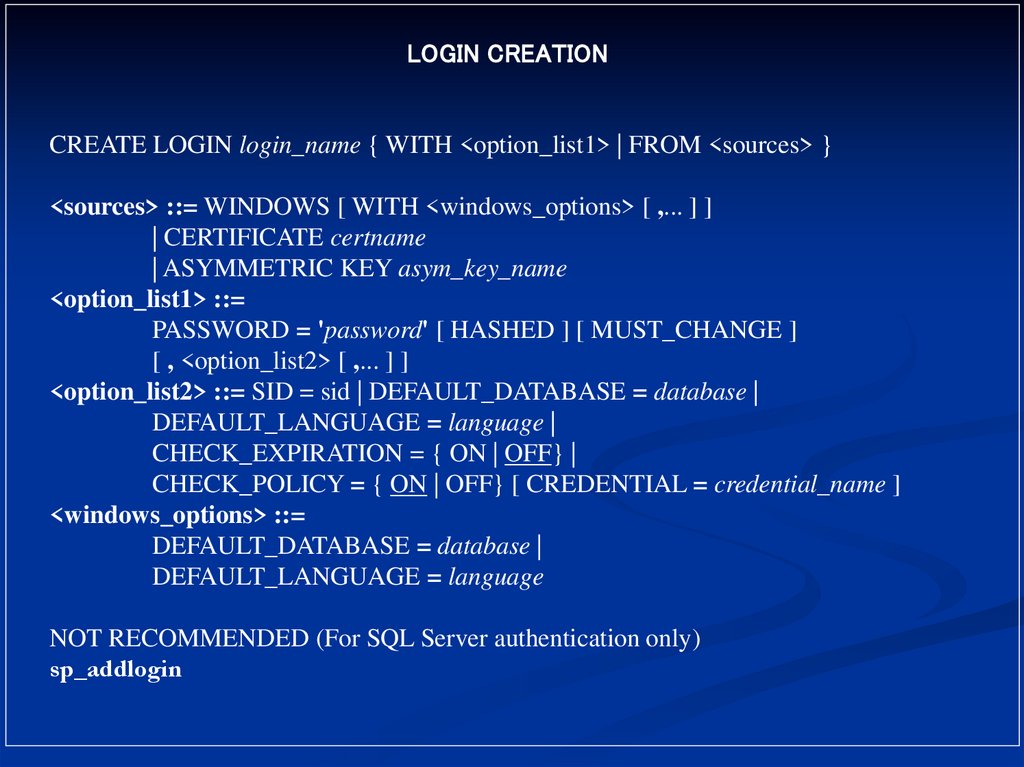
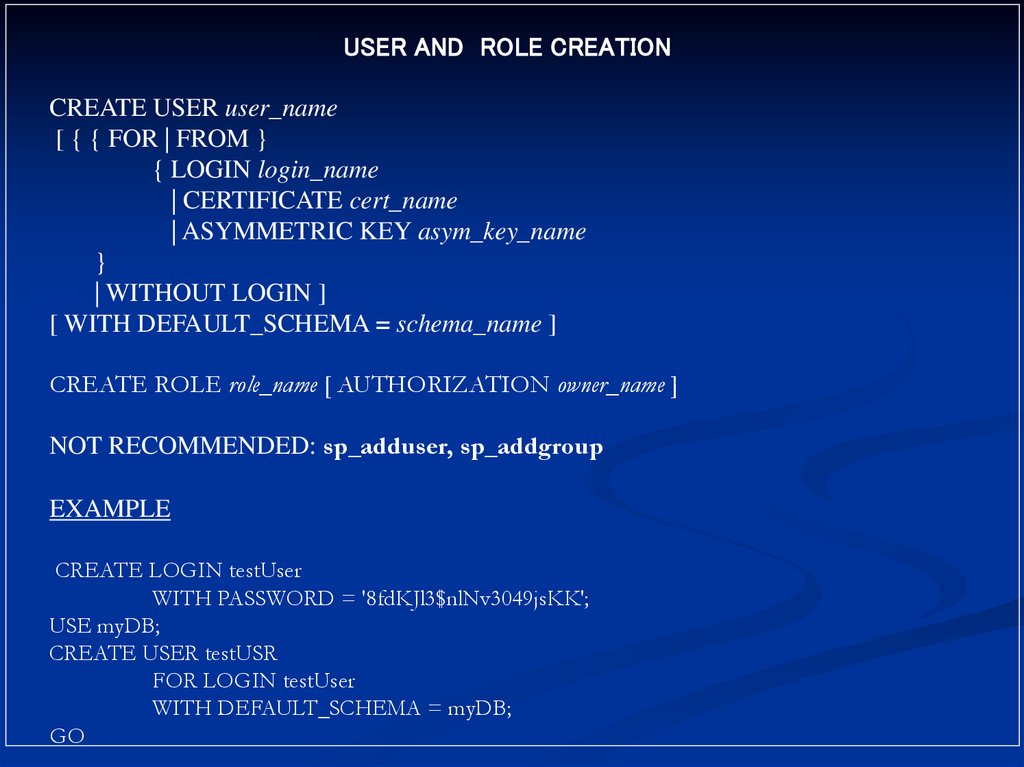
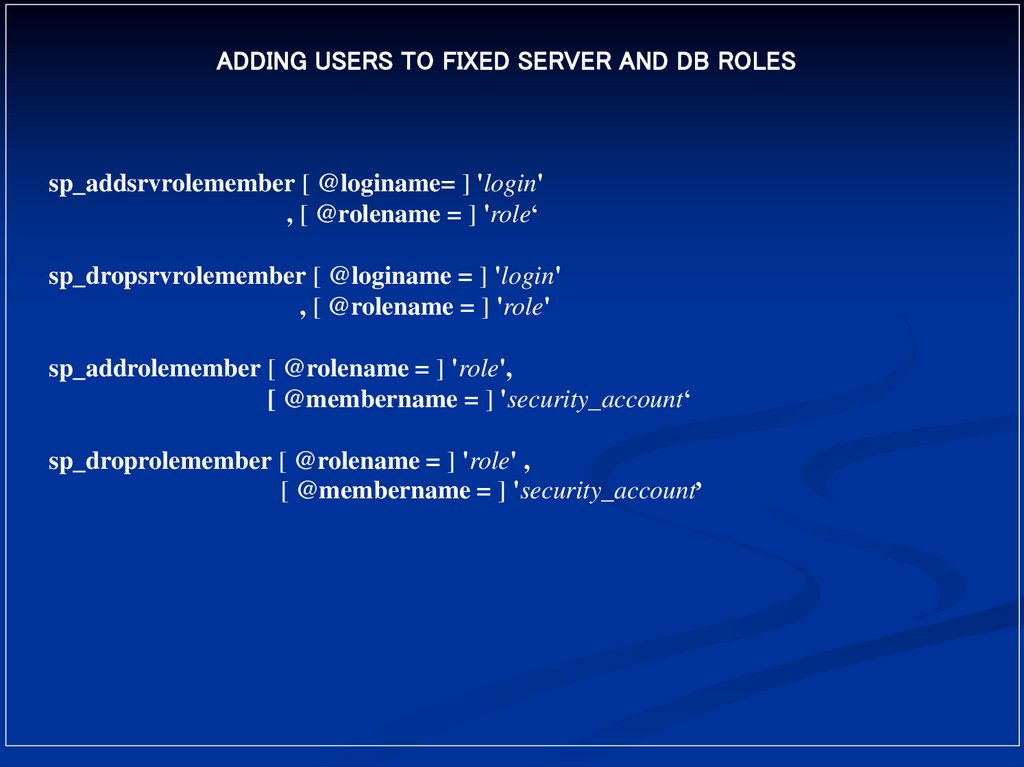
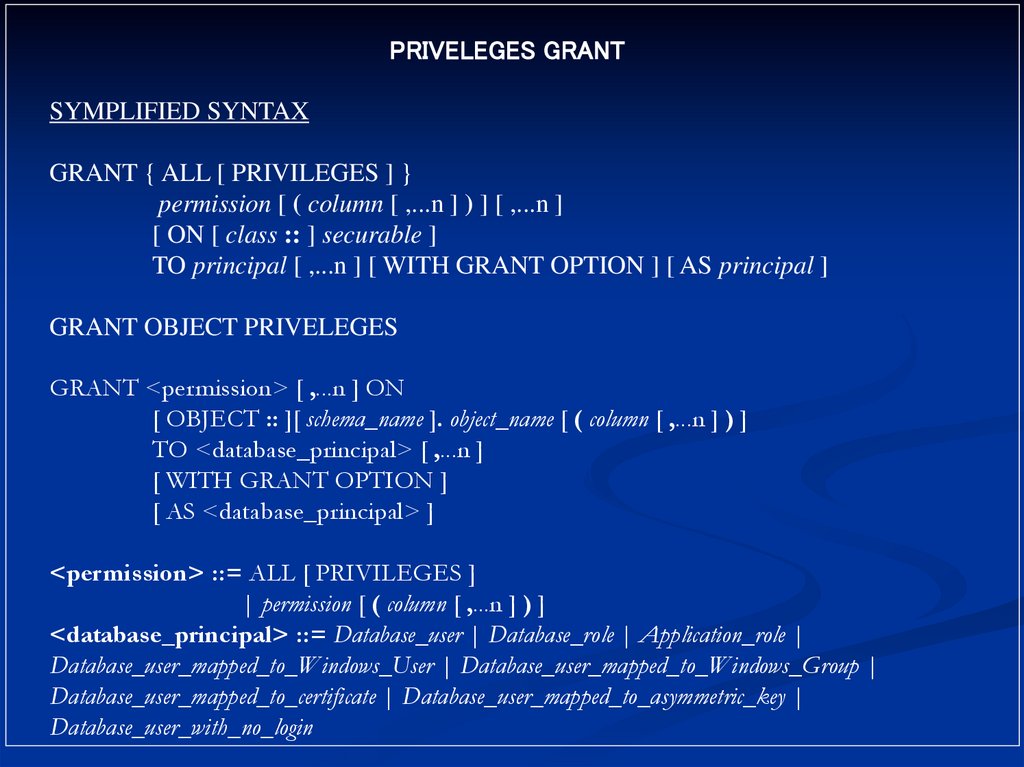
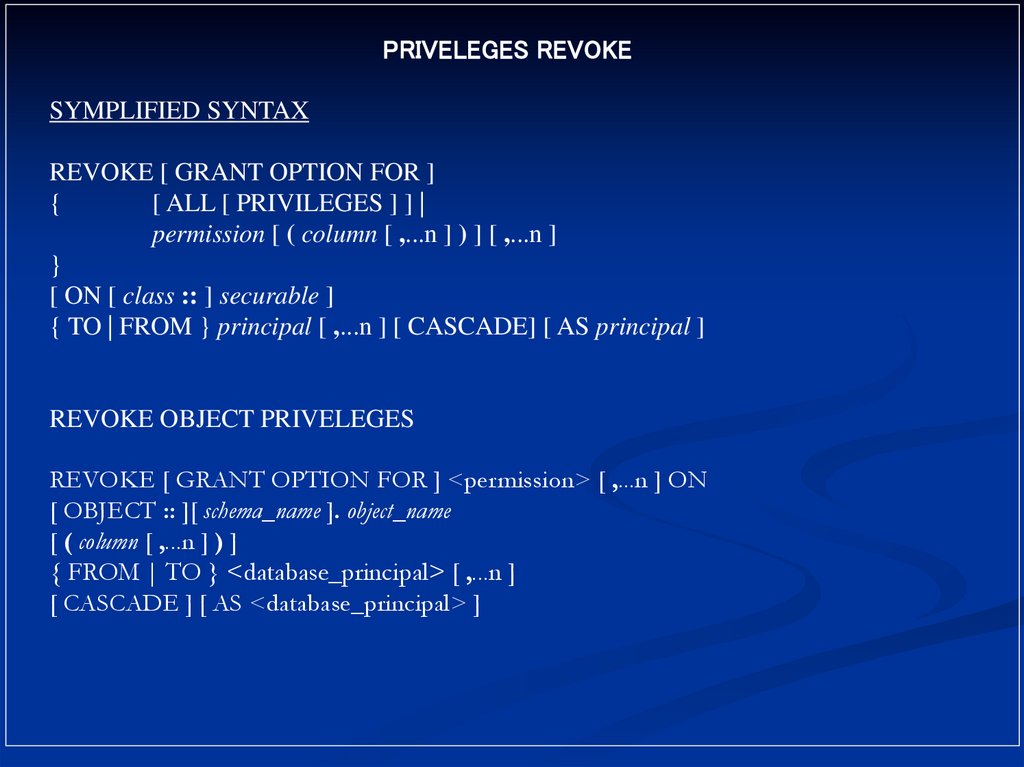
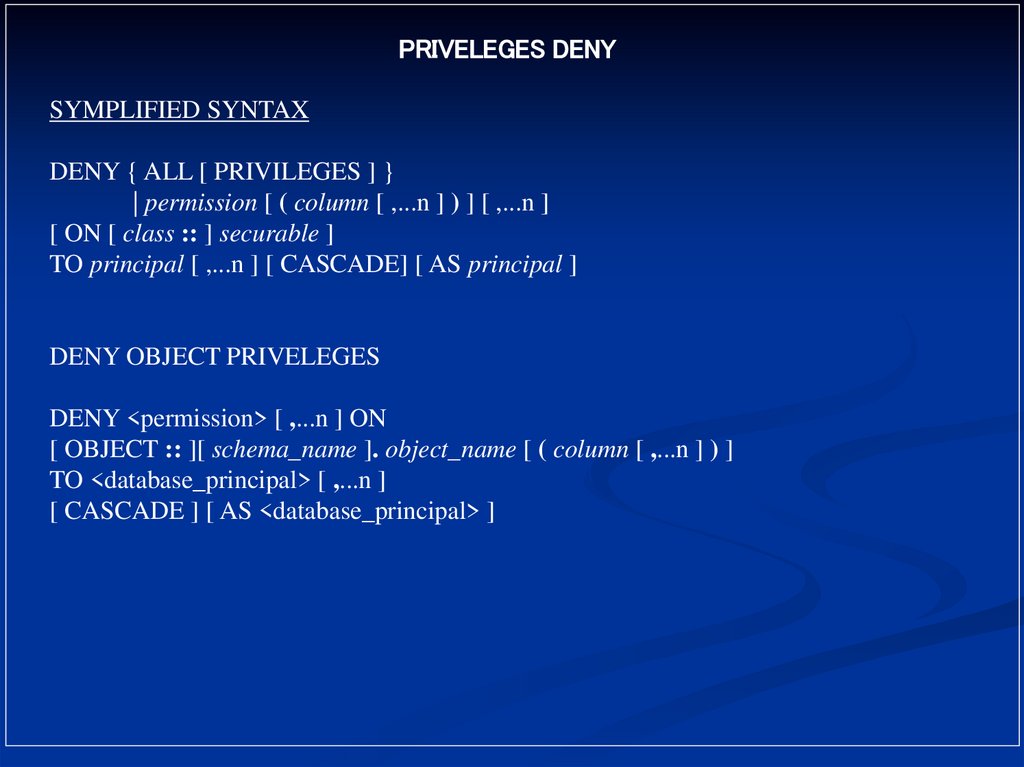
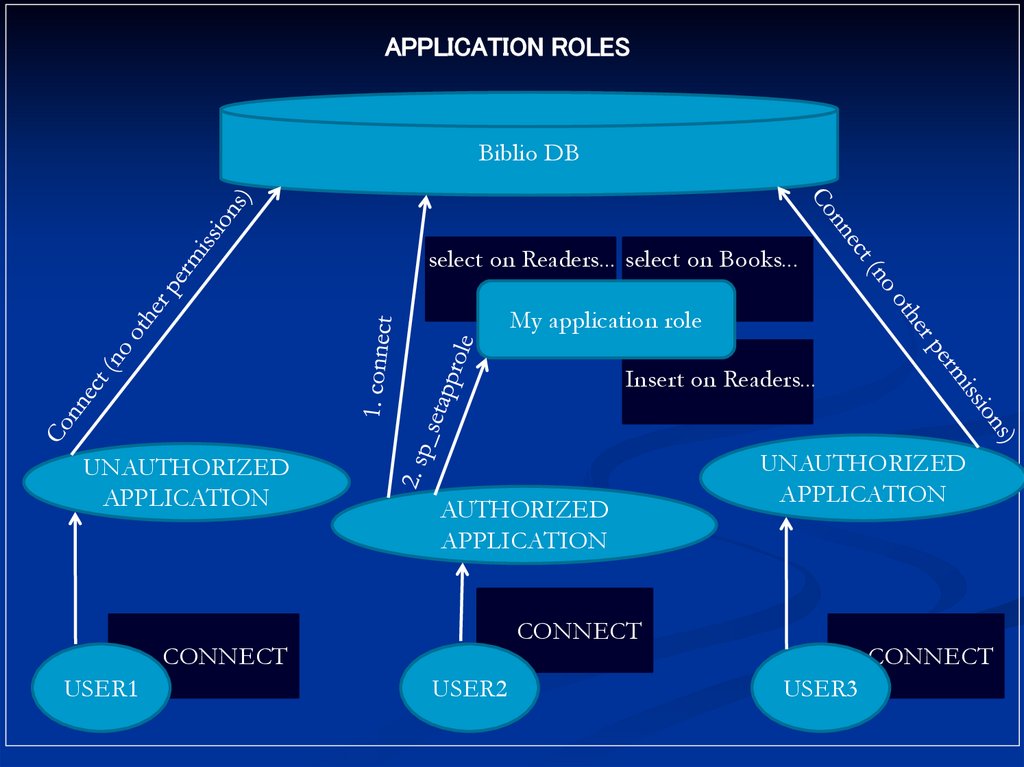
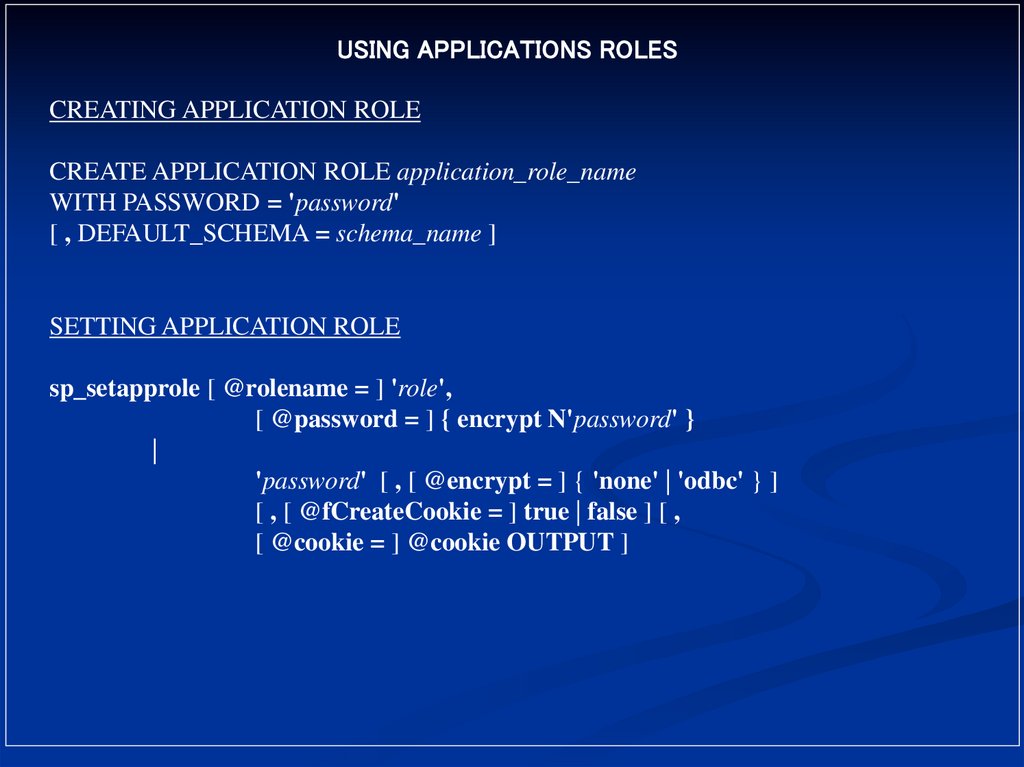
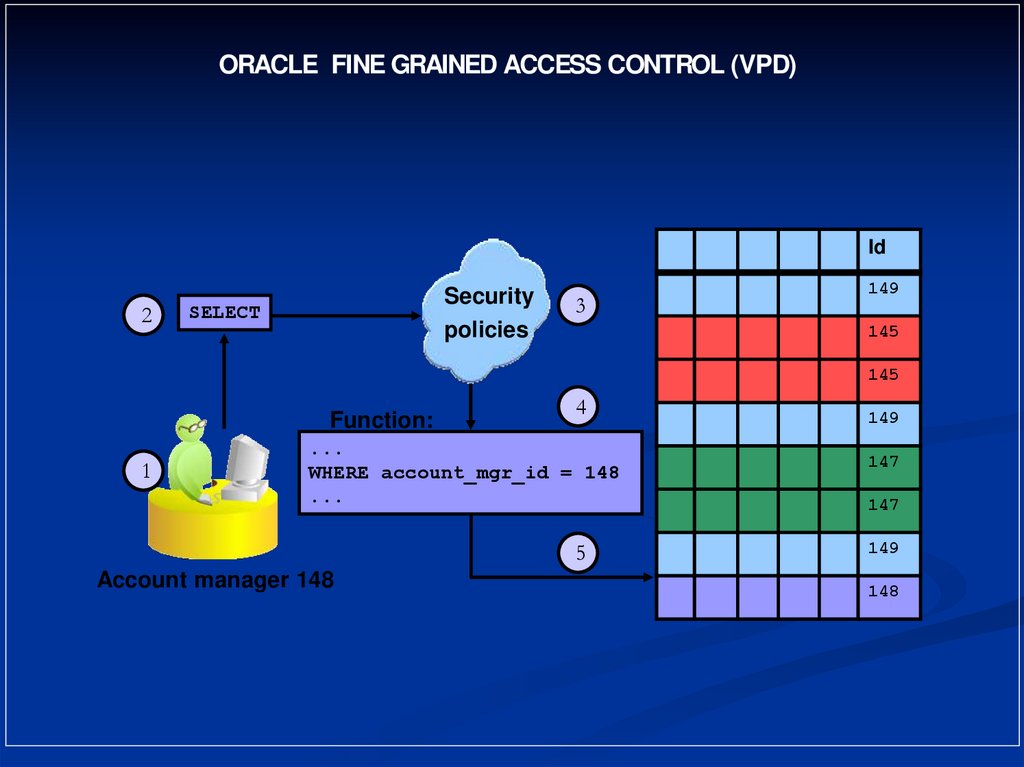
 software
software database
database








